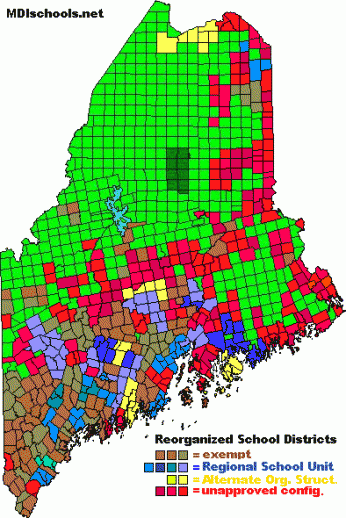Maine's School Districts
The law has failed to achieve its goal to consolidate 290 school districts into 80, with enrollments of 1,200 to 2,500 students or more. Today 218 districts remain. Maine voters rejected plans to create large school districts when they realized it would not save any money and would increase costs in many places.
As of Oct. 1, 2009:
- 66 districts were exempt from the law, either because of their size, geography or other special dispensation. These account for 55 percent of enrollment statewide.
- 126 districts are out of compliance with the law because their regionalization plans were rejected by voters. These represent 15 percent of enrollment statewide.
- 26 new regional districts were formed*. These represent 29 percent of enrollment statewide.
See Department of Education, "Reorganization Status of All School Systems": http://maine.gov/education/reorg/plansandresponses.html
History
The school consolidation law was passed as part of the biennial budget in 2007. It was an alternative to Gov. John Baldacci’s initial proposal – announced in his state-of-the-state address that year -- to reduce the state’s 290 districts down to 26 for an estimated savings of $240 million in state and local spending over three years.
That proposal was changed to call for no more than 80 districts statewide, with an average size of 2,500 students, but no fewer than 1,200. The projected savings were never quantified under the new plan although $36.5 million was cut from General Purpose Aid in anticipation of large savings.
The law required districts to form planning committees and create consolidation plans to become Regional School Units, or submit a request to be exempt from the process as an Alternative Plan unit. Those submitting consolidation plans had to put them on the local ballot to get voter approval in the existing districts. Before the Legislative session adjourned in 2008 it passed the first bill to amend the law that included a number of fixes and a provision to form a second type of school district called an Alternative Organizational Structure.
Votes were held throughout 2008 and right up until an extended deadline at the end of Jan. 2009 on 46 plans. Of those, 22 were rejected; 20 were approved; and, four were partially approved, with a piece of a proposed district winning enough voter support to be declared a new unit by the DOE. In four other cases, when a merger was rejected by voters, districts large enough to meet the student enrollment requirement applied to be an Alternative Plan and were approved.
While the law says all districts had to be voted on by Jan. 30, 2009 and operational by July 1, 2009, the Dept. of Ed. continues to work with the non-complying districts. Subsequent legislation was passed in 2009 to delay penalties for another year until July 1, 2010, and to grant an exemption to 12 inland school districts having the same isolation characteristics as offshore islands. The subjects of a multitude of other proposed bills to amend the law were set aside for review until after the November 2009 referendum. Significantly, the Legislature also passed a bill that provides for the voluntary formation of regional educational cooperatives but it is not a legal alternative to mandated consolidation.
Meanwhile, two towns that did consolidate, Steuben and Pownal, have held non-binding referenda where each voted to withdraw from its new school district. While there is no opt-out provision under the law, they felt the unforeseen consequences warranted these symbolic actions.
The school consolidation law was passed as part of the biennial budget in 2007. It was an alternative to Gov. John Baldacci’s initial proposal – announced in his state-of-the-state address that year -- to reduce the state’s 290 districts down to 26 for an estimated savings of $240 million in state and local spending over three years.
That proposal was changed to call for no more than 80 districts statewide, with an average size of 2,500 students, but no fewer than 1,200. The projected savings were never quantified under the new plan although $36.5 million was cut from General Purpose Aid in anticipation of large savings.
The law required districts to form planning committees and create consolidation plans to become Regional School Units, or submit a request to be exempt from the process as an Alternative Plan unit. Those submitting consolidation plans had to put them on the local ballot to get voter approval in the existing districts. Before the Legislative session adjourned in 2008 it passed the first bill to amend the law that included a number of fixes and a provision to form a second type of school district called an Alternative Organizational Structure.
Votes were held throughout 2008 and right up until an extended deadline at the end of Jan. 2009 on 46 plans. Of those, 22 were rejected; 20 were approved; and, four were partially approved, with a piece of a proposed district winning enough voter support to be declared a new unit by the DOE. In four other cases, when a merger was rejected by voters, districts large enough to meet the student enrollment requirement applied to be an Alternative Plan and were approved.
While the law says all districts had to be voted on by Jan. 30, 2009 and operational by July 1, 2009, the Dept. of Ed. continues to work with the non-complying districts. Subsequent legislation was passed in 2009 to delay penalties for another year until July 1, 2010, and to grant an exemption to 12 inland school districts having the same isolation characteristics as offshore islands. The subjects of a multitude of other proposed bills to amend the law were set aside for review until after the November 2009 referendum. Significantly, the Legislature also passed a bill that provides for the voluntary formation of regional educational cooperatives but it is not a legal alternative to mandated consolidation.
Meanwhile, two towns that did consolidate, Steuben and Pownal, have held non-binding referenda where each voted to withdraw from its new school district. While there is no opt-out provision under the law, they felt the unforeseen consequences warranted these symbolic actions.


